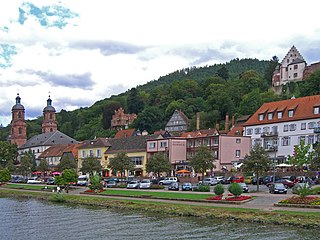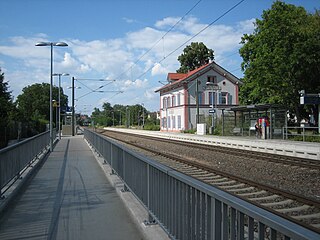
The Hôtel des Invalides, commonly called Les Invalides, is a complex of buildings in the 7th arrondissement of Paris, France, containing museums and monuments, all relating to the military history of France, as well as a hospital and an Old Soldiers' retirement home, the building's original purpose. The buildings house the Musée de l'Armée, the museum of the Army of France, the Musée des Plans-Reliefs, and the Musée d'Histoire Contemporaine. The complex also includes the Cathedral of Saint-Louis-des-Invalides, the national cathedral of the French military. It is adjacent to the Royal Chapel known as the Dôme des Invalides, the tallest church building in Paris at a height of 107 meters. The latter has been converted into a shrine to some of France's leading military figures, most notably the tomb of Napoleon.

Miltenberg is a town in the Regierungsbezirk of Lower Franconia (Unterfranken) in Bavaria, Germany. It is the seat of the like-named district and has a population of over 9,000.

Mainz Hauptbahnhof is a railway station for the city of Mainz in the German state of Rhineland-Palatinate. It is used by about 60,000 travelers and visitors each day and is therefore by far the busiest station in Rhineland-Palatinate. The station was a trial area for a CCTV scheme using automated face recognition.

Darmstadt Hauptbahnhof is the main railway station in the German city Darmstadt. After Frankfurt Hbf and Wiesbaden Hbf, it is the third largest station in the state of Hesse with 35,000 passengers and 220 trains per day.

Mainz-Bischofsheim station is the station of the town of Bischofsheim in the German state of Hesse on the Main Railway from Mainz to Frankfurt am Main. It is classified by Deutsche Bahn as a category 4 station. The station is served by the S-Bahn and regional trains. The station was opened at its current location in 1904.

Mainz Römisches Theater station is a station in the city of Mainz, the capital of the German state of Rhineland-Palatinate on the Main Railway from Mainz to Frankfurt am Main. It is the most important station in the city after Mainz Hauptbahnhof. It is classified by Deutsche Bahn as a category 3 station. The station is served by S-Bahn and regional trains.

Dietzenbach station is the terminus of the Offenbach-Bieber–Dietzenbach railway in the German state of Hesse. The station is now used exclusively by line S2 of the Rhine-Main S-Bahn. The entrance building is protected as a monument. The station is classified by Deutsche Bahn as a category 5 station.

Darmstadt Nord (north) station is a junction station in the city of Darmstadt in the German state of Hesse. The passenger station, which is served by trains of the Odenwald Railway and the Rhine-Main Railway (Rhine-Main-Bahn), has four platform tracks. Running parallel and north of the station are two additional tracks for freight traffic.

The Marktbrunnen in Mainz is a renaissance fountain located at the ″Markt″ of Mainz. It was donated by elector Albert of Mainz and crafted in the workshop of the Mainz sculptor Hans Backoffen. The Marktbrunnen represents one of the first architectural formed decorated fountains of the renaissance.

Langen (Hess) station is in the town of Langen in the German state of Hesse. It was opened in 1846 with the Main-Neckar Railway and is now served by the Rhine-Main S-Bahn. The station has two side platforms, an island platform and a through track without a platform. The station building and platform canopies are protected as monuments. It is classified by Deutsche Bahn as a category 4 station.

Darmstadt South station is in the city of Darmstadt in the German state of Hesse on the Main-Neckar Railway. The station building is protected under the Hessian Monument Protection Act. It is classified by Deutsche Bahn as a category 5 station.

Neu-Edingen/Mannheim-Friedrichsfeld station is a separation station in the Mannheim district of Friedrichsfeld on the border with the municipality of Edingen-Neckarhausen in the German state of Baden-Württemberg. All rail tracks are in Mannheim, only the station building is located on the territory of the Edingen-Neckarhausen hamlet of Neu-Enghien. It is classified by Deutsche Bahn as a category 4 station. It has been served by the Rhine-Neckar S-Bahn since December 2018.

Weidenthal station is the station of the town of Weidenthal in the German state of Rhineland-Palatinate. It lies on the Mannheim–Saarbrücken railway, which essentially consists of the Pfälzischen Ludwigsbahn, which historically connected Ludwigshafen and Bexbach. It was opened on 25 August 1849, with the Kaiserslautern–Frankenstein section of the Ludwig Railway. Its entrance building is a protected monument.

Limburgerhof station – called Mutterstadt until 1930 – is in the town of Limburgerhof in the German state of Rhineland-Palatinate. Deutsche Bahn classifies it as a category 4 station and it has two platform tracks and two through tracks. The station is located in the network of the Verkehrsverbund Rhein-Neckar and belongs to fare zone 123. Its address is Am Bahnhofsplatz 1.

Sondernheim station is a station in the Germersheim suburb of Sondernheim, in the German state of Rhineland-Palatinate. Deutsche Bahn classifies it as a category 6 station and it has two platform tracks. The station is located in the network of the Karlsruher Verkehrsverbund and belongs to fare zone 575. Since 2001, the station has also been part of the area where the fares of the Verkehrsverbund Rhein-Neckar are accepted at a transitional rate. The address of the station is Germersheimer Straße 14. Its former entrance building is under heritage protection.

Rülzheim station is a station in the town of Rülzheim in the German state of Rhineland-Palatinate. The original station was opened on 25 July 1876 with the commissioning of the Germersheim–Wörth section of Schifferstadt–Wörth railway. The address of the old entrance building, which is heritage listed, is Bahnhofstraße 6.

Rheinzabern station is the main station in the town of Rheinzabern in the German state of Rhineland-Palatinate. Deutsche Bahn classifies it as a category 6 station and it has two platform tracks. It is located on the network of the Karlsruher Verkehrsverbund. Since 2001, the station has also been part of the area where the fares of the Verkehrsverbund Rhein-Neckar are accepted at a transitional rate. Its address is Bahnhofstraße 26.

Flörsheim (Main) station is the station of Flörsheim am Main in the German state of Hesse. It lies on the Taunus Railway, which connects Frankfurt and Wiesbaden.
Herbert Dellwing was a German art historian and historic preservationist. He lived and work in Speyer and Neustadt an der Weinstraße.

Koblenz Charterhouse was a Carthusian monastery, or charterhouse, in Koblenz, Rhineland-Palatinate, Germany. It stood on the Beatusberg, a hill that forms the north-easterly tip of the Hunsrück overlooking the city. The site was first occupied by a Benedictine monastery, the Kloster St. Beatusberg, which was closed in 1315, when the monks were replaced by a community of Augustinian Canons until the Carthusians took over the site in 1331.
























